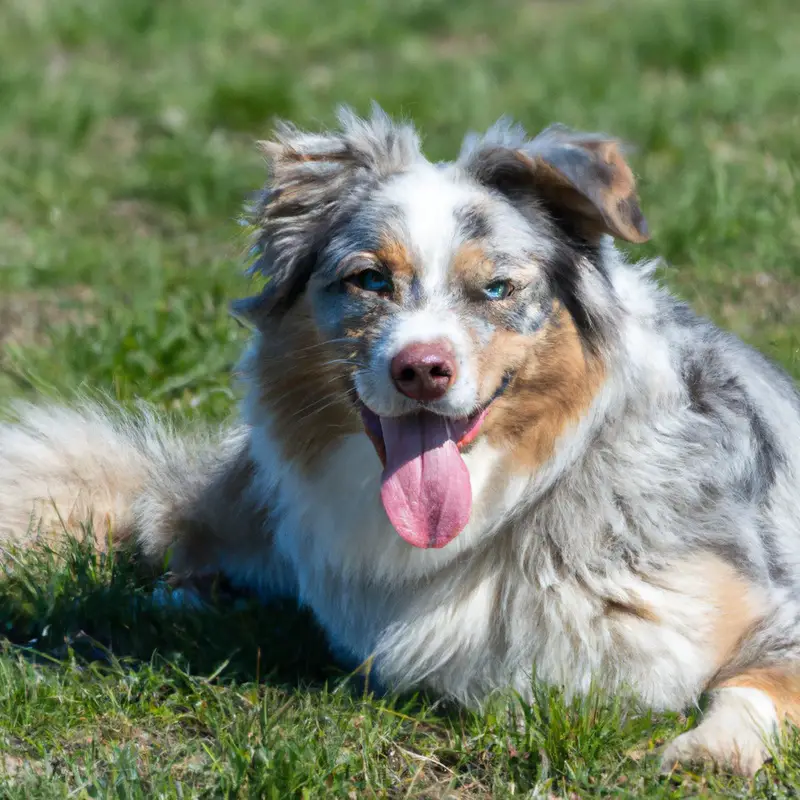How Do Australian Shepherds Handle Being Left Alone During The Day?
Key Takeaways:
- Australian Shepherds may struggle with being alone for long periods due to their high energy levels and strong attachment to their owners.
- Separation anxiety is common among Australian Shepherds when left alone, leading to destructive behaviors and excessive barking.
- Proper training, exercise, and mental stimulation can help Australian Shepherds cope with being alone and reduce separation anxiety.
- Hiring a dog walker or providing interactive toys can provide Australian Shepherds with necessary stimulation and alleviate stress when left alone.
Are you a proud owner of an Australian Shepherd, but find yourself worrying about how they cope when left alone during the day? Well, you’re not alone.
As an expert in the field, I understand the unique challenges faced by this breed when it comes to separation anxiety.
In this article, we’ll explore the fascinating history and characteristics of Australian Shepherds, and delve into the strategies and coping mechanisms that can help them thrive when you’re not around. So, whether you’re a new owner or simply seeking advice, let’s dive in and discover how to make those alone hours a breeze for your beloved Australian Shepherd!
| Positive | Negative | |
|---|---|---|
| Behavior | Australian Shepherds can adapt well to being left alone during the day. | Australian Shepherds can experience separation anxiety and may exhibit undesirable behaviors such as excessive barking or destructive chewing. |
| Exercise | Australian Shepherds are an active breed and typically require a lot of exercise. They may become restless or develop behavioral issues if not given enough physical activity. | Not providing adequate exercise can lead to pent-up energy, which may manifest as disobedience or hyperactivity. |
| Training | Australian Shepherds are intelligent and trainable. They can learn to become comfortable and independent when left alone for reasonable periods. | Lack of proper training can result in behavioral problems and an inability to handle being alone. |
| Company | Providing interactive toys or leaving a companion, such as another dog or a cat, can help alleviate loneliness and reduce separation anxiety. | Australian Shepherds are highly sociable and may struggle with being alone for extended periods, even with company. |
| Preparation | Properly preparing the environment by gradually increasing the duration of alone time and providing a safe, comfortable space can help Australian Shepherds adjust to being alone. | Sudden changes or lack of preparation can exacerbate separation anxiety and stress. |
Understanding the Australian Shepherd breed
History and background of Australian Shepherds
The history and background of Australian Shepherds is quite interesting. Despite their name, these dogs did not actually originate in Australia.
They were originally bred in the United States to work on farms and ranches.
Australian Shepherds are known for their herding abilities and were used to help with livestock, especially sheep. Their ancestors are believed to be a mix of Collies and other herding breeds brought to the United States by Basque shepherds from Australia.
Over time, these dogs became popular among American ranchers and gained recognition as a distinct breed.
Australian Shepherds are intelligent, agile, and highly trainable. They are known for their versatility and can excel in various activities such as obedience, agility, and even as therapy dogs.
They have a strong work ethic and require plenty of physical and mental stimulation to keep them happy and fulfilled.
In terms of appearance, Australian Shepherds are medium-sized dogs with a well-balanced body. They have a double coat, which helps protect them from various weather conditions.
The coat comes in different colors and patterns, including black, red, blue merle, and red merle.
Overall, Australian Shepherds are loyal, active, and loving companions. They thrive in households where they are given plenty of attention, exercise, and mental engagement.
With the right care, training, and socialization, these dogs can make wonderful additions to families or individuals who lead an active lifestyle.
Characteristics and temperament of Australian Shepherds
Australian Shepherds are known for their intelligence, loyalty, and high energy levels. They are active and enjoy having a job to do.
They are natural herders and have a strong instinct to chase and corral other animals, including children.
It’s important to provide them with plenty of physical and mental stimulation to prevent boredom and destructive behaviors. They are also highly trainable and excel in various dog sports and activities.
Socialization from an early age is crucial for Australian Shepherds to ensure they grow up to be well-rounded and friendly adults.
They thrive in homes where they have a job or purpose and receive plenty of exercise and mental stimulation.

Exercise and mental stimulation needs of Australian Shepherds
Australian Shepherds are an active and intelligent breed that require plenty of exercise and mental stimulation to stay happy and healthy. They have a high energy level and need consistent physical activity to prevent boredom and destructive behaviors.
Regular walks, runs, and play sessions are essential for meeting their exercise needs.
Additionally, Australian Shepherds thrive on mental stimulation, so incorporating puzzle toys, obedience training, and interactive games into their routine is crucial. Providing them with a variety of activities and challenges will keep their minds engaged and prevent them from becoming bored or anxious.

Australian Shepherds and separation anxiety
Overview of separation anxiety in dogs
Separation anxiety is a common behavioral issue in dogs when they are left alone. It occurs when dogs become anxious and distressed due to being separated from their owners or being in unfamiliar environments.
Dogs with separation anxiety may exhibit various signs, such as excessive barking, destructive behavior, house soiling, and pacing.
Separation anxiety can be caused by various factors, including a lack of socialization, a traumatic event, or a sudden change in routine. It is important to note that not all dogs experience separation anxiety, and some breeds, like Australian Shepherds, may be more prone to it.
Separation anxiety can be challenging to address, but with patience and consistent training, it can be managed.
It is important to gradually introduce periods of alone time, establish a routine, and provide comforting items, such as blankets or toys, to help your dog feel secure. Additionally, providing mental stimulation and enrichment activities, such as puzzle toys or treat dispensers, can help alleviate anxiety.
If your dog’s separation anxiety symptoms persist or worsen, it may be necessary to seek professional help from a veterinarian or a certified dog behaviorist.
They can provide guidance on desensitization and counter-conditioning techniques, as well as medication options if needed. Remember, each dog is unique, and what works for one may not work for another.
Patience, consistency, and understanding are key when dealing with separation anxiety in dogs.

Prevalence of separation anxiety in Australian Shepherds
Separation anxiety is common among Australian Shepherds. Many of these intelligent and loyal dogs struggle when left alone for extended periods.
Although not all Australian Shepherds develop separation anxiety, it is prevalent in this breed due to their strong attachment to their owners.
It’s important for owners to be aware of this potential issue and take steps to prevent and address separation anxiety in their Australian Shepherds. By understanding the prevalence of separation anxiety in Australian Shepherds, you can better prepare and support your furry friend.
Signs and symptoms of separation anxiety in Australian Shepherds
Australian Shepherds, like many other dogs, can experience separation anxiety when left alone. Some signs and symptoms of separation anxiety in Australian Shepherds include excessive barking or howling, destructive behavior, such as chewing furniture or digging, pacing or restlessness, attempts to escape or self-harm, and excessive drooling or panting.
They may also exhibit symptoms such as refusing to eat, urinating or defecating inside the house, or showing signs of depression when separated from their owners.
These behaviors can be distressing for both the dog and the owner, but there are strategies to help manage and alleviate separation anxiety in Australian Shepherds.
Preparing Australian Shepherds for being alone
Gradual introduction to alone time
When it comes to helping your Australian Shepherd adjust to being alone, a gradual introduction to alone time is key. Start by leaving your dog alone for short periods, then gradually increase the duration.
This will help them develop confidence and independence.
Make sure to provide engaging toys and comforting items to keep them occupied. Additionally, establish a consistent routine to help them feel secure.
By gradually introducing alone time and providing the right environment, you can help your Australian Shepherd feel more comfortable when you’re away.
Establishing a routine and leaving comforting items
When it comes to preparing your Australian Shepherd for being alone, establishing a routine is crucial. Dogs thrive on structure, so setting a regular schedule for feeding, exercise, and alone time helps them feel more secure.
By following a consistent routine, your Australian Shepherd will know what to expect and when, reducing their anxiety when you’re away.
In addition to a routine, leaving comforting items can provide reassurance for your pup. Leaving a familiar blanket, toy, or article of clothing with your scent can bring comfort and familiarity while you’re gone.
These items provide a sense of security and can help ease separation anxiety.
Remember, every dog is unique, so finding what works best for your Australian Shepherd may require some trial and error. By incorporating a routine and comforting items, you can help your furry friend adjust to being alone and make their alone time more manageable.
Training and socialization to prevent separation anxiety
To prevent separation anxiety in Australian Shepherds, training and socialization are key. Start by gradually introducing your dog to being alone for short periods, then gradually increase the duration.
Make sure to establish a consistent routine and leave comforting items, such as toys or a blanket, to help your dog feel secure.
During training sessions, focus on positive reinforcement and reward your dog for calm behavior when left alone. This will help them associate being alone with positive experiences.
It’s also important to socialize your Australian Shepherd from a young age, exposing them to various people, animals, and environments.
This will help build their confidence and reduce anxiety. Consider enrolling your dog in obedience classes or working with a professional trainer who specializes in separation anxiety.
They can provide guidance and support in developing a training plan that suits your dog’s specific needs.
Remember, every dog is unique, so it may take time and patience to find the right methods that work for your Australian Shepherd. Stay consistent, be patient, and seek professional help if needed.
With proper training and socialization, you can help prevent separation anxiety and ensure your dog feels comfortable being alone when necessary.
Coping strategies for Australian Shepherds left alone
Providing mental stimulation and enrichment activities
Australian Shepherds are intelligent and active dogs, so it’s important to provide them with mental stimulation and enrichment activities to keep them occupied when left alone. Here are some ideas:
- Puzzle toys: These toys challenge your Australian Shepherd’s problem-solving skills as they try to figure out how to get a treat or toy out of the puzzle.
- Interactive feeders: Instead of putting your dog’s food in a bowl, use interactive feeders to make mealtime more engaging. These feeders require your dog to work for their food, stimulating their brain and providing entertainment.
- Hide and seek: Hide treats or toys around the house for your Australian Shepherd to find. This engages their sense of smell and keeps them entertained as they search for their hidden treasures.
- Training sessions: Regular training sessions not only provide mental stimulation but also strengthen the bond between you and your dog. Teaching them new tricks or practicing obedience commands will keep them mentally engaged.
- Snuffle mats: Snuffle mats are specially designed mats with hidden treats or kibble that your dog has to sniff out. This activity engages their sense of smell and provides mental stimulation.
- Rotate toys: Keep your Australian Shepherd’s toys on rotation, introducing new ones periodically. This prevents boredom and keeps them interested in their toys.
Remember, mental stimulation and enrichment activities are crucial for your Australian Shepherd’s well-being and can help prevent destructive behaviors that may arise from boredom. Experiment with different activities to find what works best for your dog and always supervise them during playtime.
Interactive toys and treat dispensers for Australian Shepherds
Interactive toys and treat dispensers can be a great way to keep your Australian Shepherd entertained and mentally stimulated when they are left alone during the day. These types of toys are designed to engage their natural instincts and provide a challenge for them to solve.
There are many options available, such as puzzle toys that require your dog to manipulate objects or solve problems to receive a treat.
These toys can keep your Australian Shepherd occupied and focused, and they also provide them with a tasty reward for their efforts. Some interactive toys even have adjustable difficulty levels, so you can increase the challenge as your Australian Shepherd becomes more skilled.
This can help prevent them from getting bored or frustrated with the toys too quickly.
Additionally, treat dispensers are another great option. These toys hold treats that can only be accessed by your dog when they figure out how to manipulate the toy.
This not only keeps them entertained but also provides mental stimulation as they work to retrieve their tasty reward.
When choosing interactive toys and treat dispensers for your Australian Shepherd, it’s important to consider their size and durability. Look for toys made from high-quality materials that can withstand their strong jaws and energetic play.
Remember, interactive toys and treat dispensers are not a replacement for human interaction and exercise, but they can be a helpful tool in keeping your Australian Shepherd mentally stimulated and entertained while you’re away.
Hiring a dog walker or considering doggy daycare
If you’re looking for ways to help your Australian Shepherd cope with being alone during the day, hiring a dog walker or considering doggy daycare can be excellent options.
- With a dog walker, you can ensure that your Australian Shepherd gets some exercise and mental stimulation while you’re away. A dog walker can take your furry friend for a walk or engage them in playtime, helping to break up their day and alleviate boredom.
- Doggy daycare is another great choice, especially if your Australian Shepherd enjoys being around other dogs. They’ll have the opportunity to socialize, play, and burn off energy in a supervised environment. This can help prevent loneliness and separation anxiety.
- When choosing a dog walker or doggy daycare, make sure to do your research. Look for reputable providers who have experience with Australian Shepherds and positive reviews from other pet owners.
- Discuss your Australian Shepherd’s specific needs and preferences with the dog walker or daycare staff. This will ensure that they can cater to your furry friend’s unique requirements and provide the necessary care and attention.
By considering these options, you can give your Australian Shepherd the company, exercise, and stimulation they need, helping them to stay happy and content while you’re away.
Dealing with separation anxiety in Australian Shepherds
Recognizing and addressing separation anxiety triggers
Recognizing and addressing separation anxiety triggers in Australian Shepherds is important for their well-being. It’s essential to understand what triggers their anxiety and take steps to alleviate it.
Some common triggers can include changes in routine, being left alone for long periods, or experiencing a traumatic event.
To recognize these triggers, pay attention to your dog’s behavior when you’re about to leave or when they are alone. Signs of separation anxiety may include excessive barking, pacing, destructive behavior, or even self-harm.
Understanding these triggers can help you address them effectively.
Addressing separation anxiety triggers involves creating a safe and secure environment for your Australian Shepherd. Gradual desensitization and counter-conditioning techniques can help them become more comfortable being alone.
Start by leaving for short periods and gradually increasing the duration as they become more confident.
Establishing a routine and leaving comforting items, such as their favorite toys or an article of clothing with your scent, can also help alleviate their anxiety. These familiar objects can provide reassurance and make them feel less alone.
Training and socialization are crucial in preventing separation anxiety.
Teaching your Australian Shepherd basic obedience commands can help them feel more secure and confident. Socializing them with other dogs and people can also reduce their anxiety levels.
If your Australian Shepherd’s separation anxiety becomes severe or persists despite your efforts, seeking professional help is recommended.
A veterinarian or a professional dog trainer experienced in dealing with separation anxiety can provide guidance and even suggest medication if necessary. Remember, every Australian Shepherd is unique, and what works for one may not work for another.
Patience, consistency, and understanding are key when addressing separation anxiety triggers.
With time and proper care, you can help your Australian Shepherd feel more secure and content when left alone.
Desensitization and counter-conditioning techniques
Desensitization and counter-conditioning techniques are effective methods for helping Australian Shepherds cope with separation anxiety. Desensitization involves gradually exposing your dog to being alone for short periods, starting with just a few minutes and gradually increasing the time.
This helps them become more comfortable and less anxious when left alone.
Counter-conditioning involves pairing the experience of being alone with something positive, such as treats or a favorite toy. This helps to change your dog’s emotional response from fear or anxiety to a more positive one.
For example, you can give your dog a special treat or engage them in a fun activity when you leave and when you come back.
It’s important to be patient and consistent when using these techniques. Start with short periods of alone time and gradually increase the duration over time.
Be sure to give your Australian Shepherd plenty of positive reinforcement and rewards for calm behavior.
Remember, every dog is different, so it’s important to tailor these techniques to your individual dog’s needs. If you’re having trouble or your dog’s separation anxiety is severe, it may be beneficial to seek the help of a professional dog trainer or behaviorist who can provide personalized guidance and support.
Seeking professional help and medication options
If your Australian Shepherd is experiencing severe separation anxiety, seeking professional help and considering medication options may be necessary. It’s important to consult with a veterinarian or a professional dog behaviorist who specializes in separation anxiety to get the right guidance.
They can assess your dog’s specific needs and create a customized treatment plan.
A professional may use techniques like desensitization and counter-conditioning to help your Australian Shepherd gradually adjust to being alone. These methods involve gradually increasing the amount of time your dog spends alone in a positive and controlled manner.
With patience and consistency, your dog can learn to feel more comfortable when you’re away.
In some cases, medication may be prescribed to help manage your Australian Shepherd’s anxiety. Medications like selective serotonin reuptake inhibitors (SSRIs) or anti-anxiety medications can be used alongside behavior modification techniques to provide relief to your dog.
It’s essential to follow the veterinarian’s instructions and closely monitor your dog’s response to any medication.
Remember, professional help and medication options should be considered if your Australian Shepherd’s separation anxiety is severe or if other methods haven’t been effective. With the right support and treatment, you can help your furry friend overcome their anxiety and feel more relaxed when you’re not around.
Alternative solutions and considerations
Hiring a pet sitter or dog nanny
Hiring a pet sitter or dog nanny can be a great option for Australian Shepherds who are left alone during the day. They can provide companionship and care for your furry friend while you’re away.
A pet sitter or dog nanny can come to your home and spend quality time with your Australian Shepherd.
They can take them for walks, play games, and provide mental stimulation. Having someone there to interact with your dog can help alleviate their boredom and separation anxiety.
It’s important to find a reliable and trustworthy pet sitter or dog nanny.
You can ask for recommendations from friends, neighbors, or your veterinarian. Make sure to interview potential candidates and ask about their experience, qualifications, and how they would handle any potential issues that may arise.
Additionally, you may want to consider a trial period to see how your Australian Shepherd responds to the pet sitter or dog nanny.
It’s essential to ensure that they form a positive bond and that your dog feels comfortable in their presence. Keep in mind that hiring a pet sitter or dog nanny can be a more expensive option compared to other alternatives.
However, the added benefits of personalized care and attention for your Australian Shepherd may outweigh the cost.
Remember to discuss your dog’s specific needs, routine, and any special instructions with the pet sitter or dog nanny. This will help them provide the best possible care for your furry friend while you’re away.
Overall, hiring a pet sitter or dog nanny can be a valuable solution for Australian Shepherds who are left alone during the day.
It provides them with companionship, mental stimulation, and peace of mind for you as a pet owner.
Exploring pet monitoring cameras and two-way communication devices
Pet monitoring cameras and two-way communication devices can be valuable tools for keeping an eye on and interacting with your Australian Shepherd while you’re away. These devices allow you to remotely monitor your dog’s activities and behavior through a live video feed.
You can also use the two-way communication feature to talk to your dog and offer reassurance.
When exploring pet monitoring cameras, look for features such as high-definition video quality, night vision capability, and motion detection alerts. Some cameras even have the option to dispense treats or play pre-recorded messages to entertain your dog.
Two-way communication devices may come in the form of standalone devices or be integrated into pet monitoring cameras.
By using pet monitoring cameras and two-way communication devices, you’ll have peace of mind knowing that you can check on your Australian Shepherd throughout the day. These devices can also help alleviate separation anxiety by allowing you to interact with your dog and provide comfort when needed.
Remember to introduce your Australian Shepherd to the camera or device slowly and positively so they become accustomed to it.
Some dogs may be initially curious or wary of the device, so it’s important to make it a positive and rewarding experience. With time and familiarity, your Australian Shepherd will adjust to the presence of the monitoring camera or two-way communication device.
While pet monitoring cameras and two-way communication devices can be helpful, it’s essential to remember that they are not a substitute for human interaction and companionship.
Australian Shepherds are social animals and still require regular exercise, mental stimulation, and socialization with humans and other dogs. It’s also important to ensure the camera or device is securely installed and to protect your privacy by using secure passwords and encryption.
Additionally, some cameras may require a stable internet connection, so make sure your home network is reliable.
Adopting another dog as a companion for your Australian Shepherd
Adopting another dog can be a great option to provide companionship for your Australian Shepherd. Having a furry friend to keep each other company can help alleviate separation anxiety and provide mental stimulation.
When considering another dog, it’s important to choose a breed and individual that will get along well with your Australian Shepherd.
Consider their size, energy level, and temperament. Introduce them gradually and supervise their interactions to ensure a positive relationship.
Adoption can be a rewarding experience for both you and your Australian Shepherd.
Final Verdict
Understanding the unique needs of Australian Shepherds when it comes to being left alone is crucial for their well-being. These intelligent and active dogs require mental stimulation and exercise to prevent boredom and potential separation anxiety.
By gradually introducing alone time, establishing a routine, and providing engaging activities, owners can help their Australian Shepherds cope with being left alone.
However, it’s important to recognize the signs of separation anxiety and seek professional help if needed. Considering alternative solutions like hiring a pet sitter or adopting a companion dog can also provide additional support.






